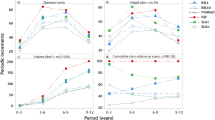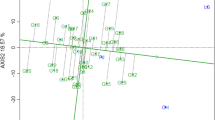Abstract
Growth, survival, stem characteristics, resistance to wind, and canker disease of 51 poplar clones were evaluated at age 9 and 10 years, and compared to measurements at age 3 in two trials on the Lower Valley of the Colorado River, Argentina. About 30% of the clones in both trials had large changes in growth rankings at age 9 and 10 compared to rankings at age 3. Canker incidence increased about 4-fold between age 3, and measurements at age 9 and 10. Stem form was in general satisfactory, and wind incidence was almost nil. In trial 1, clones 588–1, Conti 12, 582–41, and 582–5 occupied the upper positions in the growth rankings at age 3 and 10, and the clone 588–1 ranked first both in growth and canker incidence in 1998. Stem growth trajectories of clones with similar growth rates did not differ among clones with, and without canker disease. In trial 2, the range in growth among clones was narrower than in trial 1, and canker disease, although of minor incidence, was present in most clones at age 9. Some of the P. deltoides clones in the trials had similar growth, and less canker disease than the Euroamerican clones commonly grown in the region, but progressive canker incidence should be addressed with additional selection trials.
Similar content being viewed by others
References
Abrahamson L.P., White K.H., Nowak C.A., Briggs R.D. and Robinson D.J. 1990. Evaluating hybrid poplar clonal growth potential in a three-year-old genetic selection field trial. Biomass 21: 101-114.
Allen S.J., Hall R.L. and Rosier P.T.W. 1999. Transpiration by two poplar varieties grown as coppice for biomass production. Tree Physiol 19: 493-501.
Ares A. and Gutierrez L. 1993. Aspectos de la populicultura en el Valle Inferior del Río Colorado. Comportamiento de las especies y clones más difundidos. Rev. Asoc. For. Arg. 47: 49-60.
Ares A. and Gutierrez L. 1996. Selection of poplar clones for the Lower Valley of the Colorado River, Argentina. Forestry 69: 75-82.
Browaldh M. 1995. The influence of trees on nitrogen dynamics in an agrisilvicultural system in Sweden. Agrofor. Syst. 30: 301-313.
Brown K.R., Bead F.D. and Hogan G.D. 1996. Establishment-year height growth in hybrid poplars; relations with longer-term growth. New For. 12: 175-186.
Chambers P.G.S. and Borralho N.M.G. 1997. Importance of survival in short rotation tree breeding programs. Can. J. For. Res. 27: 911-917.
DeBell J.D. and Gartner B.L. 1997. Stem characteristics on the lower log of 35 year old western red cedar grown at several spacings. Western J. Appl. For. 12: 9-14.
Foster G.S. 1988. Provenance variation of eastern cottonwood in the Lower Mississippi Valley. Silvae Geneticae 35: 32-38.
Gutierrez L. and Ares A. 1996. Aspectos de la populicultura en el Valle Inferior del Río Colorado. Nivel técnico de la actividad. Rev. Asoc. For. Arg. 50: 71-78.
Hansen E., Heilman P.E. and Strobl S. 1992. Clonal testing and selection for field plantations. In: Mitchell C.P., Ford-Robertson J.B., Hinckley T. and Sennerby-Forese I., Ecophysiology of Short-rotation Forest Crops. Elsevier Applied Science Publishers, Oxford, UK, pp. 124-145.
Hartigan J.A. 1975. Clustering Algorithms. John Wiley and Sons Inc., New York.
Heilman P.E. 1999. Planted forests: poplars. New For. 17: 89-93.
Heilman P.E. and Xie F. 1993. Influence of nitrogen on growth and productivity of short-rotation Populus trichocarpa x Populus deltoides hybrids. Can. J. For. Res. 23: 1863-1869.
Jug A., Makeschin F., Rehfuuess K.E. and Hofmann-Schielle C. 1999. Shortrotation plantations of balsam poplars, aspen and willows on former arable land in the Federal Republic of Germany. III. Soil ecological effects. For. Ecol. Manage 121: 85-99.
Lo M.H., Abrahamson L.P., White E.H. and Manion P.D. 1995. Early measures of basal area and canker disease predict growth potential of some hybrid poplar clones. Can. J. For. Res. 25: 1113-1118.
Mitchell C.P. 1994. Developments in the production and supply of wood for energy. Renewable Energy 5: 754-761.
Muhairwe C.K. 1994. Tree form and taper variation over tine for interior lodgepole pine. Can. J. For. Res. 24: 1904-1913.
Newman S.M. 1997. Poplar agroforestry in India. For. Ecol Manage. 90: 13-17.
Park J., Newman S.M. and Cousins S.H. 1994. The effects of poplar (P.trichocarpa x deltoides) on soil biological properties in a silvoarable system. Agrofor. Syst. 25: 111-118.
Rogers D.L., Stettler R.F. and Heilman P.E. 1988. Genetic variation and productivity of Populus trichocharpa and its hybrid. III. Structure and pattern of variation in a 3-year field test. Can. J. For. Res. 19: 372-377.
Scarascia-Mugnozza G.E., Ceulemans R., Heilman P.E., Isebrands J.G., Stettler R.F. and Hinckley T.M. 1997. Production physiology and morphology of Populus species and their hybrids grown under short rotation. II. Biomass components and harvest index of hybrid and parental species clones. Can. J. For. Res. 27: 285-294.
Scordo J.C. and Arreghini R.I. 1983. Ensayo comparativo de adaptación de 19 clones de Populus sp. cultivados en Tunuyán (Mendoza) Proc. 5th Argentinean Forestry Congress., pp. 1122-1126.
Soil Survey Staff 1992. Keys to Soil Taxonomy, SMSS Technical Monograph No. 19. 5th edn. Pocahontas Press, Blacksburg, USA.
Steenackers J., Steenackers V., Van Acker J. and Stevens M. 1993. Stem form, volume and dry matter production in a twelve-year-old circular Nelder plantation of Populus trichocharpa x deltoides 'Beaupre'. For. Chron. 69: 730-735.
SYSTAT 1997. SYSTAT 7.0 Statistics. Chicago, USA.
Tabbush P. and Beaton A. 1998. Hybrid poplars: present status and potential in Britain. Forestry 71: 355-364.
Tschaplinski T.J., Tuskan G.A., Gebre G.M. and Todd D.E. 1998. Drought resistance of two hybrid Populus clones grown in a large-scale plantation. Tree Physiol. 18: 653-658.
van den Driessche R. 1999. First-year growth response of four Populus trichocarpa x Populus deltoides clones to fertilizer placement and level. Can. J. For. Res. 29: 554-562.
Zobel B. and Talbert J. 1984. Applied Forest Tree Improvement. J. Wiley and Sons, New York, USA.
Zsuffa L. 1975. Some problems of hybrid poplar selection and management in Ontario. For. Chron. 51: 240-242.
Author information
Authors and Affiliations
Rights and permissions
About this article
Cite this article
Ares, A. Changes through time in traits of poplar clones in selection trials. New Forests 23, 105–119 (2002). https://doi.org/10.1023/A:1015687708505
Issue Date:
DOI: https://doi.org/10.1023/A:1015687708505




